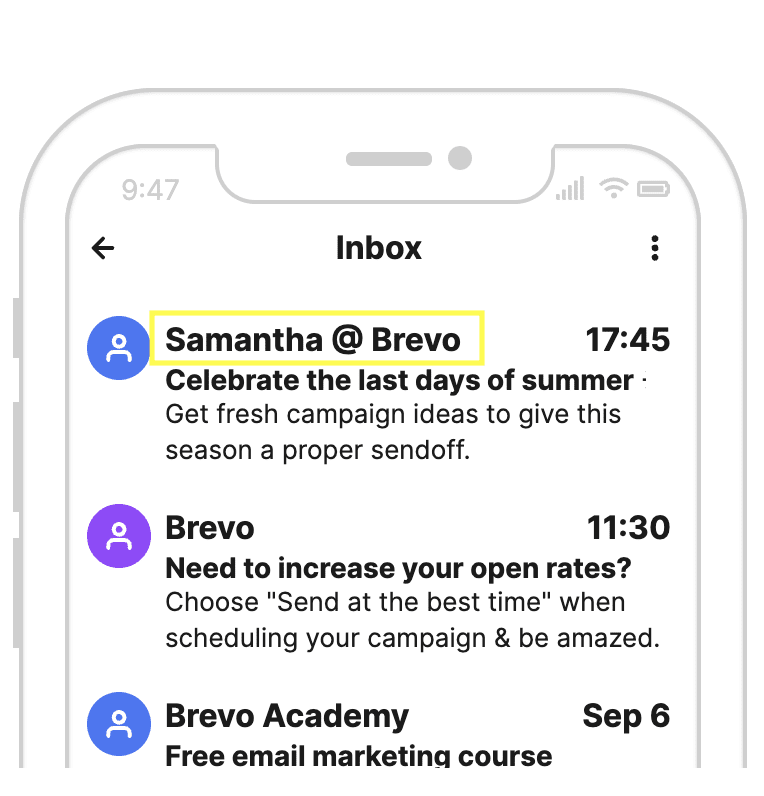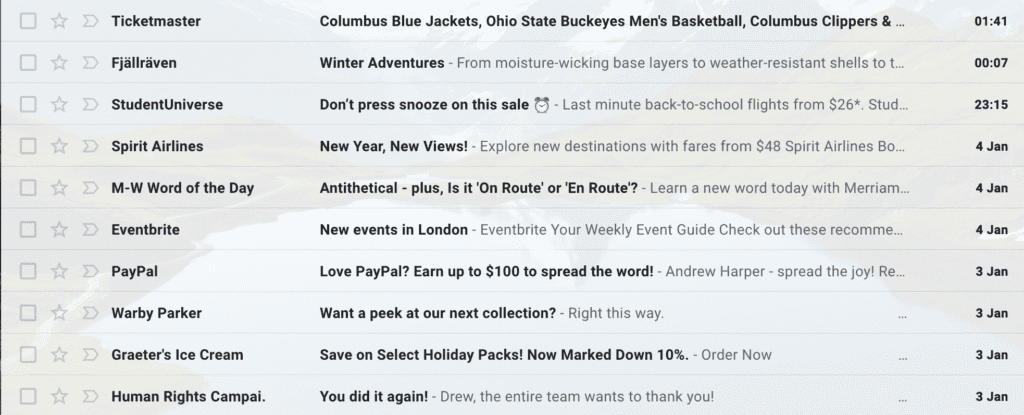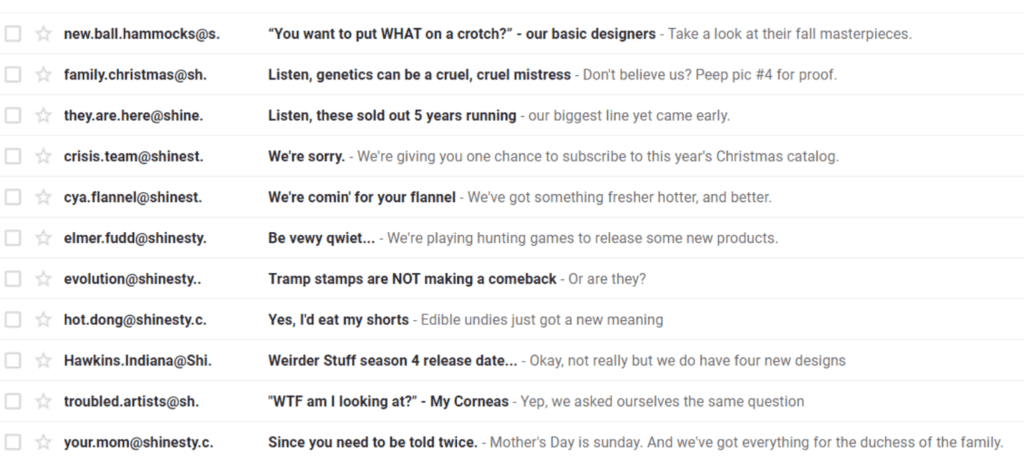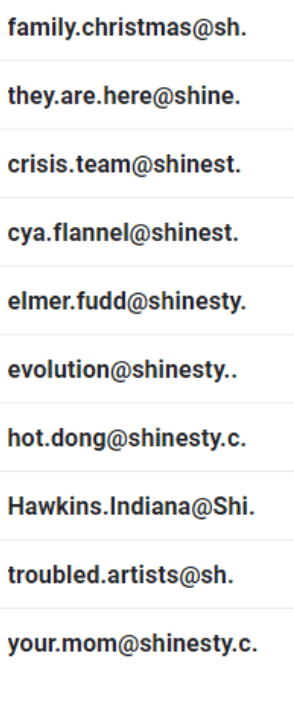
Email sender name is the one of the most influential factors in whether recipients will open your email. It’s your brand reputation, condensed into under 200 pixels. Yet email sender name best practices are often overlooked.
This blog post helps you understand why, in email marketing, sender name matters. It lays out all current industry best practices. After reading it, you’ll have the information you need to decide which email sender name best practices fit your brand and why.
What is an email sender name?
An email sender name (also: from name) is the display name in your contacts’ inboxes. It’s different from the sender address (also: from address or from email), which includes an @ and a domain name. A from name displays 20-30 characters, depending on the email client, browser, and device.

Example of an email sender name
Why are email sender names important?
Email sender names can have a huge impact on your marketing campaigns’ success. In fact, a survey of American consumers found that 42% of people look at the sender name first when deciding whether to open an email.
Many marketers underestimate the role sender name plays in boosting open rates. However, it can often be just as important in encouraging subscribers to open your campaign as email subject lines.
The good news about the email sender name is that, unlike a subject line, you don’t need to change it with every email. In fact, you shouldn’t. But you do need to put time into optimizing it before you settle down with the version(s) that work for your brand.
The four parts of an email sender name
The four components that make up a successful email sender name are trustworthiness, brand recognition, consistency, and segmentation. Let’s take a look at each in more detail.
1️. Trustworthiness
As they’re browsing their email inbox, your audience is subconsciously wondering “Which ones are legit?”
Your contacts look at the sender name first because it tells them if your email is spam or not. They take less than a second to make that decision.
One simple way to pass the initial trustworthiness test is to use your legitimate company name. This is really a no-brainer, and there’s no need to overthink things here.
But, whatever you do, make sure your sender name displays a real name, whether it be the company’s name or an employee’s personal name, not just an email address. Your contacts are expecting to encounter a person or company name in this field, not something impersonal like [email protected].
Note: Make sure your sender email address comes from a trustworthy domain, too. Gmail, Yahoo, or AOL email addresses don’t look professional. You run the risk of your messages ending up in a spam filter like flies on sticky paper if you send mass mailings from Gmail and the like.
2️. Brand recognition
Trustworthiness is just one building block for a successful sender name. Brand recognition comes next.
After asking themselves if you’re legit, your contacts are now wondering, “Do I know you?”That’s why companies almost always include the brand name in the from name itself.
Even if you want to personalize, for example, that email newsletter you’re sending by letting everyone know it’s from “Mara,” make sure you tell them it’s from “Mara at Brevo” so brand recognition is immediate.
However, if your sender name is longer than 20–30 characters, it will be truncated in some email users’ displays. The better your brand reputation is with your contacts, the less of a problem this is.
3️. Consistency
Consistency complements and reinforces brand recognition, which is why it’s the third element for winning the email sender name game.
Once you’ve found a certain sender name formula that generates opens, stick with it. You want brand recognition to be immediate and subconscious.
Note: If your from name changes every time, you might confuse your subscribers and risk damaging your reputation with them.
4️. Segmentation
Segmentation will help you optimize your email sender name. In general, the different types of emails your company sends should have different sender names. This will help your contacts instantaneously categorize them. Here are some examples:
- Send transactional emails, such as order confirmation emails, from “Orders at Company”
- Send newsletters from an individual employee, “Sam at Company”
- Send straightforward ad campaigns from the company name, “Company”
Over time, paying attention to your sender name is an essential part of optimizing your open rate, click-through rate, and conversions. Optimizing your sender name can even improve email deliverability in the long run.
Developing a strategy for your sender name will give your email campaigns more and more credibility in the eyes of your clients and your clients’ email service providers.
Pro tip: Make sure you use an email marketing tool like Brevo that lets you preview and test different sender names for your campaigns.
Best practices for email sender names
To better understand when and how to segment, let’s look at the four most popular email marketing formulas for from name and see which situations they fit best.
Company name
The most common sender name is simply your company name.
Knowing how important sender name is for establishing trustworthiness and brand reputation, you can understand why many brands choose this.

As you can see from these examples, it’s especially fitting for the e-commerce sector and all B2C sales campaigns.

Your customers signed up for your email list because they love (or are at least curious about) your brand. So put what they love front and center: your brand name.
Alternatively, you can send emails from “Team Company.” But don’t use the word “team” if it will add character length that truncates the brand name in the display field.
Sending from “Team Company” conveys the sense of the people working together behind the brand. It adds a personal touch.
First name at company
Another way to convey a personal touch is to send from a specific employee using the pattern: First Name at/from/@ Company.

This is especially popular in the B2B sector. Here’s why it’s a good idea:
- B2B sales is relationship selling. An email sent from an individual sales or marketing team member serves to build personalized relationships between you and your leads.
- Using employee first names gives you the chance to introduce several members of your team. It shows new prospects or clients who you are. Yes, you’re real people, and you care about them.
- First names are personal and short.
In most cases, it’s generally best to stick to first names only. Unless your full name is short and sweet like “Ed Li,” using full name plus company name will inevitably cut off the company name in most email clients’ inboxes.
There are a few exceptions to this rule. If your full name will be recognizable to your contacts on its own, you can put it in the sender name (more on that below).
But otherwise, don’t risk cutting the company name from the display at the expense of the full name. Remember, your brand name is the most important aspect of your sender name.
Full name
If your full name IS your brand, then you should be using that as your sender name. This is usually the case for influencers, industry thought leaders, or celebrities.

For example, full names are popular with entrepreneurs who have their own newsletters. If you’re marketing yourself and your specialized knowledge – whether that be writing tips or fitness tutorials – then put your full name front and center.
Genre / Service Type
The fourth common formula for sender name is to let your subscribers know what type of message or service the email contains.
Some examples of this:
- PayPal Transfers (notifying you that you just received a payment)
- Google Location Sharing (reminding you that you are sharing my location with someone)
- TransferWise Rate Alerts (sharing this morning’s EUR-USD exchange rate)
For large companies, using a sender name that differentiates one type of email from another reveals key information about the message itself.
The sender name can include the brand name plus an additional piece of information giving more details about what’s inside. Use these for alerts, briefings, transactional emails, and any mailings consumers expect to be automated.
Shinesty: a rule-breaking email sender name case study
Email sender name best practices exist for a reason. But sometimes, companies can break the rules in a way that’s consistent with their brand. Take a look at these email sender names from Shinesty, a popular underwear company.

Go ahead and look a little more closely:

Kind of crazy right?
These sender names violate all the rules of trustworthiness established above.
Do they look professional? Do they feel trustworthy? Here’s all the ways you can answer “no” to those questions:
- They use lowercase letters
- They formulate their address as if it’s an email address (which we tell you above to NEVER do because it looks haphazard and unprofessional)
- The company name isn’t always visible in the sender name field
- Perhaps the biggest violation of trustworthiness is the occasional crass language used in the sender name field
And yet, this works incredibly well for Shinesty. (And they’ve got the marketing awards to back up their success.)
Their brand character is the in-your-face rebel, who scoffs at the idea of professionalism in any context, including marketing. They pride themselves on selling “the most outlandish collection of clothing the world has ever seen.”
They’ve taken a marketing feature most people don’t even stop to think about (the from name), and turned it into another venue for outlandish branding.
They’re also smart about how they do this:
- They use lowercase letters and a lack of spacing to signal informality
- This also gives them more pixel space in the display field
In short, their brand makes a point that it doesn’t agree with traditional ideas of trustworthiness and marketing professionalism. They’re showing you how they’re throwing tradition out the window to do something else.
When it comes to brand recognition and consistency, they run the risk that their readers won’t recognize them at first. Especially with their run-on names that sometimes cut off the company name.
However, the silly email sender names instantly grab attention. Eventually, subscribers start to expect these kinds of sender names from their brand.
So, in fact, they’re following the dictates of brand recognition and consistency. They craft their sender name according to a specific, repeated formula – [email protected] – and that’s how they create brand recognition.
Finally, when it comes to segmentation, Shinesty is adapting the sender name to all marketing emails .In fact, they’re using the sender name field to convey additional information about the topic of that particular email campaign.
Lessons from Shinesty: the email sender name takeaway
Shinesty’s marketing is not for everyone. And they’re OK with that. Because what they do works for their target group.
Importantly, however you feel about Shinesty’s brand of marketing, the undeniable takeaway is that breaking the rules can work well as long as you’re consistent and clever about it.
So go ahead and break all these rules — as long as you do so in a consistent manner that’s in line with your brand voice.
Choosing the email sender name that fits your brand and message
Whether you go for the classic “Company Name” in the sender name field, “First Name from Company Name,” or another alternative, make sure you know:
- Why you’re choosing that formulation
- How the formulation fits your brand
- If the sender name is short enough to fit most email client displays or where the display will cut off
Your sender name will be the first thing your contacts look at. It’s one of the most important aspects of your email marketing strategy so make sure to get it right.
Optimize your email sender name with BrevoOur free plan lets you access 40+ free templates, send up to 300 emails/day, track key campaign metrics, and view your sender name and preview text across top email clients. |






